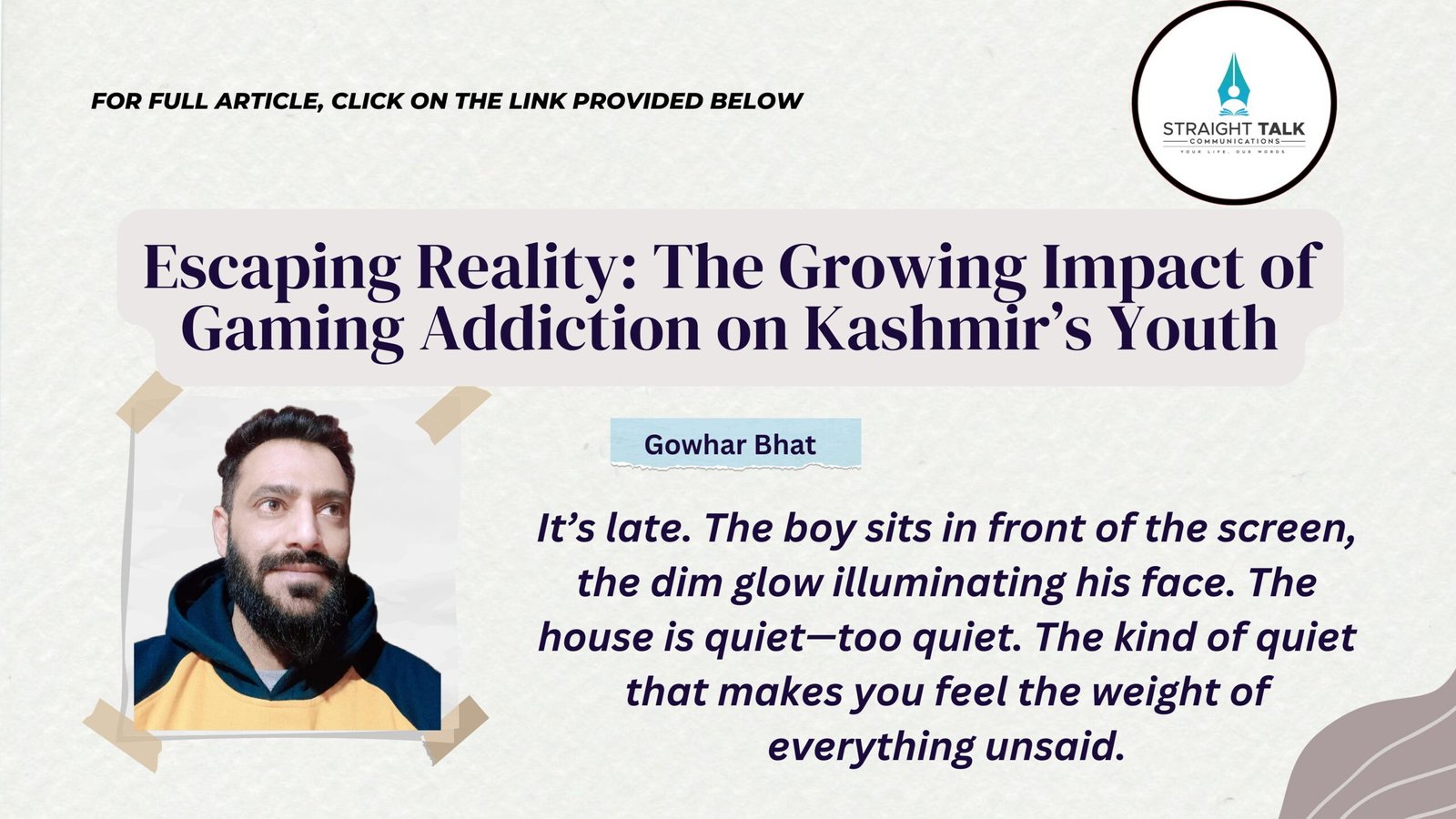Escaping Reality: The Growing Impact of Gaming Addiction on Kashmir’s Youth

Gowhar Bhat
It’s late. The boy sits in front of the screen, the dim glow illuminating his face. The house is quiet—too quiet. The kind of quiet that makes you feel the weight of everything unsaid. His parents are down the hall, asleep. They don’t know he’s still up. He doesn’t want them to know. They’ll just ask why he’s still awake, why he’s not getting rest for school tomorrow. But tomorrow is the same as today, and the day before that. It’s a pattern. The same arguments. The same looks. The same disappointment. The game is his escape.
He doesn’t think much about it. It’s something to pass the time. It used to be fun. He used to laugh, feel joy as he played, as he defeated other players and completed missions. But now, it’s just a habit. Something to do when the hours stretch too long and there’s nothing else to fill them. He clicks buttons, moves his character across the screen. The world outside seems far away. There’s nothing in it that holds his attention anymore, nothing that calls to him like the game does. So, he plays.
Sometimes, when the game doesn’t seem as interesting, when the screen starts to blur in front of his tired eyes, something stirs inside him. A feeling, maybe. A sense of regret, or maybe a longing he can’t explain. He doesn’t know exactly what it is, but it’s always there, lurking at the back of his mind. The feeling of a life that’s slipping away. But he always goes back to the game. It’s easier that way. It’s predictable. It’s safe.
Dr. Sameena Bashir, a clinical psychologist, explains that gaming addiction often goes unnoticed, disguised as typical teenage behavior. Parents dismiss it as a phase, thinking their child will eventually grow out of it. But the consequences can be severe. Increased isolation, poor academic performance, and deteriorating mental health are all signs that addiction is taking root. The boy doesn’t sleep. He doesn’t eat properly. And when he’s not playing, he’s angry. Angry at the world, angry at the people around him, angry because nothing seems to make sense anymore. Angry because the game is the only place where he feels he has control.
The games aren’t cards on a threadbare carpet. No cousins shouting over a match of carrom. No laughter echoing through the park. No real connection to anyone. Instead, it’s headsets, log-ins, and usernames—“ShadowKiller,” “Wolf_9,” “SilentReaper”—all fighting for victories that never seem to last. And when the game ends, they press “Play Again.” It’s the same cycle. The same empty pursuit of something they can’t hold on to.
But it’s never enough. And it never will be.
The Signs No One Talks About
Gaming addiction doesn’t announce itself. There are no telltale signs like with substance abuse. No empty bottles or needles lying around. Instead, it hides behind the glow of screens. It quietly alters lives, reshapes relationships, and builds walls between people. The World Health Organization (WHO) defines gaming disorder as a pattern of behavior in which the individual prioritizes gaming over all other activities, leading to significant impairments in personal and social functioning. It’s easy for families to miss, especially when they don’t understand how much it has taken over their child’s life.
One of the psychologist from Srinagar adds that the emotional consequences of gaming addiction can be severe. The screen becomes a barrier, keeping the player from the real world. It isolates him from the people who care about him. Families see the changes—the blank expressions, the irritability, the withdrawal from family events—but feel powerless to stop it. They don’t know how to reach him anymore. They don’t know how to pull him out of the world he’s created inside that screen.
The Families Left Waiting
Not every family understands what’s happening. A father stands by the door to his son’s room, confused. He remembers his own childhood, the hard work in the orchard after school, the fresh air, the camaraderie with his friends. His son won’t even step outside. “It’s just a game,” the father says. But it isn’t just a game. Not anymore.
Mothers wait with cold plates of rice, the meal growing colder with every passing minute. The boy doesn’t come. They knock on his door, ask him to join them, but he refuses. “Five more minutes,” he says. Always five more minutes. And those five minutes stretch into hours. Hours into days. The boy may be physically present in the house, but emotionally, he’s miles away. The house feels empty. Even though it’s full of people.
For the parents, it’s a battle of patience and confusion. They’ve raised their child with values of family, hard work, and connection. Yet they feel as though they’ve lost him to a game. The emotional disconnect grows, turning what was once a close-knit family into strangers who share the same space. The frustration builds. In one house, a father pulled the internet plug. The boy screamed, tore at the wires, refusing to let go of the connection. In another house, a mother deleted the game from her son’s phone. He didn’t speak to her for days.
It’s easy to dismiss this as normal teenage behavior, something all kids go through. But the signs are there. Disconnectedness. Emotional withdrawal. Lost time. WHO reports that if gaming disorder is not addressed, it can lead to long-term psychological consequences. The boy might lose more than just his interest in the game. He might lose his ability to connect with the world around him.
A Way Back
Not every story ends in shadows. Some boys do come back. The consoles collect dust. The phones sit unused. It’s not easy, but it happens.
Counselors suggest families establish routines—shared meals, walks, time together that pulls the boys out of their rooms and into the real world again. Providing alternatives to gaming is crucial to breaking the cycle. A boy who once lived for gaming might rediscover the joy of real-world experiences, like playing sports or even just spending time with family.
One boy, after several counseling sessions, began talking about cricket. By the fifth session, he had joined a local team. His father came to watch. The boy didn’t win, but that didn’t matter. That day, it wasn’t about winning. It was a small victory for both the boy and his father—a step back toward the world outside the screen. The boy rediscovered what it was like to interact with others, to feel the warmth of the sun, the satisfaction of working toward something that didn’t exist inside a game.
The mountains are still there. The rivers run. And in the fields, there are footprints where boys chase after a ball, not a screen. Life beyond the game is still waiting, always has been. And with the right guidance, it’s possible to reconnect to the real world, where relationships and experiences offer fulfillment that no screen ever can.
Outside the game, the world waits. It always has.
(The author is a published author, freelance journalist, creative writer, and experienced English instructor.)







